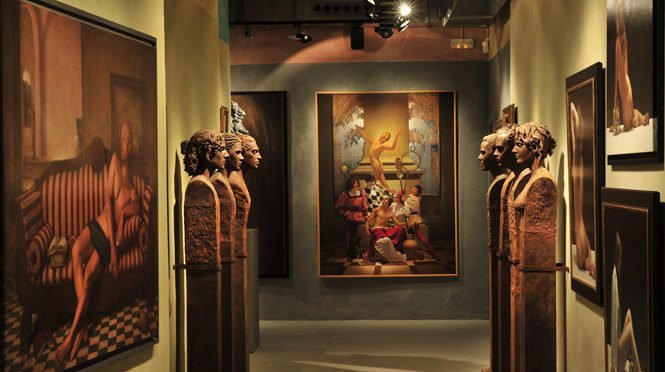The most common way for a living artist to get their paintings into a museum is to win or be a finalist in an international art competition. The annual BP Portrait Award exhibits winners at the National Portrait Gallery in London. Another example would be the Art Renewal Centers (ARC) annual award that includes a museum exhibit at the Museum European Art Modern (MEAM) in Barcelona.
The second most common way is to be invited by a curator for a theme. In the late 1980’s a curator named Jean Hubert Martin brought together the voices of artists from Africa, the Australian Aboriginals and Latin America for the Center Pompidou and the Grand Hall in Paris called Magicians of the Earth.
Often a curator has presented a thesis on a movement and releases its publication with a tour of work that had prevalence in that movement. Helen Molesworth the former Chief Curator of MOCA LA (with Dieter Roelstraete and Ian Alteveer) deeply researched the life retrospective of Alabama artist Kerry James Marshal. Curators often work with multiple museums sharing the exhibition costs. The Marshal exhibit traveled from MCA Chicago to the MET Breuer and then finished at the MOCA LA. (Artists do not make money from their work hung in a museum unless the museum buys a piece of art later).
The third way is if an artists work (usually someone of great fame or demand at auctions) has become something of interest in the art world. This would include some of the billionaire artists like John Currin and Ed Ruscha. (For more on billionaire and millionaire living artists, please read my article on Starving Artists vs Millionaire Artists.
The fourth way for your art to exhibited at a museum is for a prominent collector to be invited to display their collection. These can be older, family collections like The Borghese or the Farnese Collection in Rome, or modern art collectors like Doris and Donald Fisher who founded San Francisco’s Gap Inc. Usually these collections reflect artists with well documented auction and gallery demand or well loved in their community. Collectors will often exhibit their treasures to increase the value of the whole collection (saving the expense of insurance premiums). If you see the collection in a home magazine it is usually a signal the collection or several pieces of it will be up for sale or on loan. No one advertises their collection for burglars.
The fifth way is for the museum (usually a specialty museum like The Rosicrucian Egyptian Museum) to reach out to people who paint under that criteria. In my case it was an exhibit based on the theme of The Mythic Image. Artist Gage Taylor (d.2000) and I had collaborated on paintings of archetypal themes that repeated in the East, the Middle East, and the West for 17 years.
Thank you for reading this article. For more articles on what galleries look for in an artist and other art eccentricities, please click through to the articles below.
- What Galleries Look for When You Submit Your Art for Representation • Uriél Danā Fine Art
- Art Critics: Keeping Art In Its Proper Framework • Uriél Danā Fine Art
- Museums In The 21st Century: The Invisible Intimacy Of Public Palaces • Uriél Danā Fine Art
Cover image: Museu Europeu d’art Modern – MEAM Barcelona, Spain

